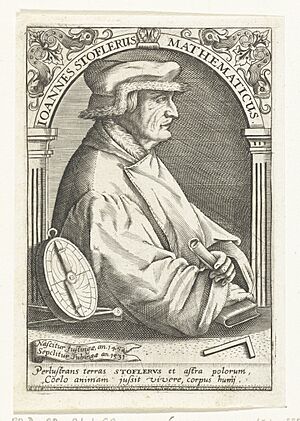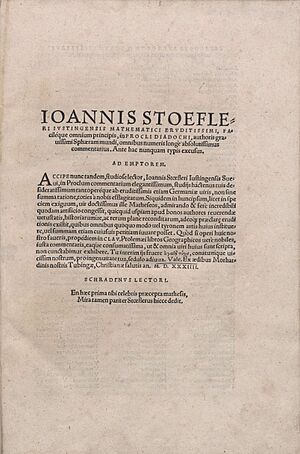Johannes Stöffler facts for kids
Johannes Stöffler (born December 10, 1452 – died February 16, 1531) was a smart German man. He was a mathematician, astronomer, and even an astrologer. He was also a priest and a professor at the University of Tübingen. Stöffler was very good at making special tools for looking at the stars.
Contents
A Life of Learning
Johannes Stöffler was born in a place called Justingen, which is now part of Schelklingen. He went to school at a monastery in Blaubeuren. Later, in 1472, he started studying at the new University of Ingolstadt. He earned his first degree, a Baccalaureus, in 1473. By 1476, he had earned his Magister degree.
After finishing his studies, Stöffler became a priest in Justingen. Besides his church duties, he spent a lot of time on his favorite subjects. These included astronomy (the study of stars) and astrology (the belief that stars affect our lives). He also enjoyed making astronomical instruments, special clocks, and celestial globes. He often wrote letters to other important thinkers of his time, like Johannes Reuchlin. For Reuchlin, he even made a special tool called an equatorium and wrote horoscopes.
In 1499, Stöffler made a prediction that a huge flood would cover the world on February 20, 1524.
Teaching and Publishing
In 1507, a duke named Ulrich I helped Stöffler get a new job. He became a professor of mathematics and astronomy at the University of Tübingen. There, he taught many students and wrote many books. He was even chosen to be the rector (head) of the university in 1522.
By this time, Stöffler was very well known for creating ephemerides. These were tables that showed where planets and stars would be on certain dates. He worked with Jacob Pflaum to continue the calculations started by another famous astronomer, Regiomontanus. Their tables were used for many years.
One of his most important books was about how to build and use an astrolabe. This book was called Elucidatio fabricae ususque astrolabii. It was printed many times and was a key guide for astronomers and surveyors for a long time.
Two of his most famous students were Philipp Melanchthon and Sebastian Münster.
Later Life and Death
In 1530, a serious illness called the plague spread. It forced the university to split up and move to different places. Stöffler went to Blaubeuren. He died there on February 16, 1531, from the plague. He was buried in the church in Tübingen.
Important Works
Here are some of the things Johannes Stöffler created or wrote:
- 1493: He made a celestial globe for the Bishop of Konstanz. This globe is the only one left from his workshop. You can see it today at the Landesmuseum Württemberg in the Old Castle in Stuttgart.
- 1496: He built an astronomical clock for the Minster (a large church) in Konstanz.
- 1498: He made another celestial globe, this time for the Bishop of Worms.
- 1499: He published an Almanac called Almanach nova plurimis annis venturis inserentia. He worked on this with Jakob Pflaum. It continued the star tables of Regiomontanus. This almanac was very popular and was printed 13 times until 1551. It greatly influenced how people studied stars during the Renaissance.
- 1512 - 1514: He wrote notes on Ptolemy's Geography. This was a handwritten book with his thoughts on the first two parts of Ptolemy's work. It is kept at the University of Tübingen. Other parts of his notes were lost in a fire.
- 1513: He wrote a book about how to build and use an astrolabe. It was called Elucidatio fabricae ususque astrolabii. This book was printed 16 times until 1620. In 2007, it was translated into English for the first time.
- 1514: He created astronomical tables, which were called Tabulae astronomicae.
- 1518: He suggested changes for the calendar in his book Calendarium romanum magnum. His ideas helped create the Gregorian calendar that we use today.
- 1534: After he died, a book of his notes was published. It was a commentary on a work called Sphaera by someone known as pseudo-Proclus.
Legacy
A crater on the Moon is named "Stöfler" (with one 'f') to honor him.
See also
 In Spanish: Johannes Stoeffler para niños
In Spanish: Johannes Stoeffler para niños



